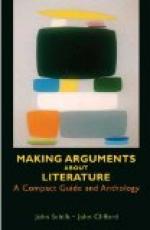Another reason why the rules of evidence at the common law have little bearing on the arguments of everyday life is like that which makes it unwise to dwell much on the burden of proof: there is no one either competent or interested to enforce the exclusion. Assertion and rumor must be more than palpably vague before the ordinary man will of his own initiative take the trouble to scrutinize it; and even in refuting such material you must make its untrustworthiness very patent if you expect to make ordinary readers distrust it seriously.
28. Direct and Indirect Evidence. When we come now to consider how we establish facts, whether single or complex, we find that, both to aid our own judgment and to convince other people, we rely on evidence. We have seen that evidence falls roughly into two classes: either it comes from persons who testify out of their own observation and experience, or it comes indirectly through reasoning from facts and principles already established or granted. The two kinds of evidence run into each other, and the terms commonly used to describe them vary: “direct evidence” is not infrequently, as in Huxley’s argument (see p. 240), called “testimonial,” and “indirect evidence,” as in the same argument and in the opinion of Chief Justice Shaw, quoted below, is called “circumstantial.” On the whole, however, the opposition between the two classes, so far as it is of practical importance, may best be indicated by the terms “direct evidence” and “indirect evidence.” The distinction between the two classes is made clear in the following extract from the opinion of Chief Justice Shaw of the Massachusetts Supreme Court. It will be noticed that it is the same doctrine as that laid down by Huxley (see p. 240).
The distinction, then, between direct and circumstantial evidence is this. Direct or positive evidence is when a witness can be called to testify to the precise; fact which is the subject of the issue in trial; that is, in a case of homicide, that the party accused did cause the death of the deceased. Whatever may be the kind or force of the evidence, this is the fact to be proved. But suppose no person was present on the occasion of the death,—and of course no one can be called to testify to it,—is it wholly unsusceptible of legal proof? Experience has shown that circumstantial evidence may be offered in such a case; that is, that a body of facts may be proved of so conclusive a character, as to warrant a firm belief of the fact, quite as strong and certain as that on which discreet men are accustomed to act in relation to their most important concerns....




